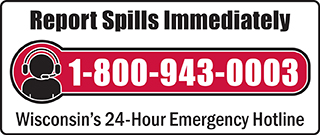What is a spill?
A spill is a discharge of one or more hazardous substances into the environment. It is usually characterized as a recent occurrence with an acute risk. A spill requires immediate response and reporting. The person or entity that caused the spill or owns or controls the property where the spill occurred (i.e., the responsible party) always requires proper containment, cleanup and disposal after a spill.
Spills can include many things, including but not limited to a tanker truck rollover, failure of a storage tank valve or failure of a wall in a manure storage lagoon.
Call the 24-hour emergency hotline at 800-943-0003 for immediate spill reporting.
The DNR provides spill response oversight and support.
Hazardous Substance Discharges
A hazardous substance is a substance that may pose a threat to human health or the environment because of its quantity, concentration or physical, chemical or infectious characteristics. A hazardous substance may include petroleum-based products, agricultural or industrial chemicals, wastewater, manure or other substances that may threaten human health or the environment. All discharges of hazardous substances must be reported and proper containment, cleanup and disposal are always required.
Discharges of hazardous substances generally fall into one of two broad categories:
- Spills that require an immediate response.
- Discharges discovered through analysis.
Discovery Of Discharges Through Analysis
Discharges of hazardous substances to the environment may be discovered when sampling and laboratory analysis of soil, sediment, vapor, indoor air or water shows evidence that a discharge occurred (e.g., a Phase II Environmental Site Assessment is completed and contaminated soil and groundwater is discovered).
Reporting is required for this type of discharge to the environment. Report discoveries of hazardous discharges using the online Notification for Hazardous Substance Discharge Form – Non-Emergency Only (Form 4400-225). Don't wait for a written report describing the contamination – immediately submit the form or make a phone call to a DNR regional office. Directions for submitting the form are available on the RR Program Submittal Portal webpage. Please include a summary of the laboratory data with the form.

